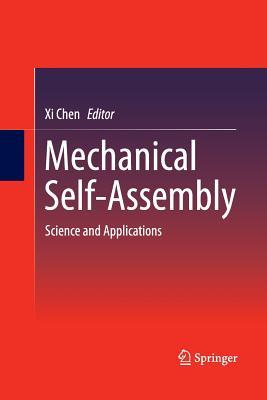Full Download Mechanical Self-Assembly: Science and Applications - Xi Chen file in PDF
Related searches:
Mechanical instability driven self-assembly and architecturing of 2D
Mechanical Self-Assembly: Science and Applications
Mechanical Self-Assembly: Science and Applications: Chen, Xi
Mechanical Self-Assembly - Science and Applications Xi Chen
Mechanical Self-Assembly: Science and Applications - Google Books
Mechanical Self-Assembly : Science and Applications (2012
Mechanical Self-Assembly: Science and Applications eBook
Collagen self-assembly and the development of tendon
Teslaphoresis and the Self-Assembly of Carbon - Evolving Science
Functional materials and devices by self-assembly MRS
The mechanical self-assembly process is inherently quick, simple, and cost-effective, as well as accessible to a large number of materials, such as curved surfaces for forming three-dimensional small structures. Mechanical self-assembly is complementary to, and sometimes offer advantages over, the traditional micro- and nano-fabrication.
May 11, 2018 researchers are manipulating temperature to control the assembly and interactions of the particles.
Sep 28, 2017 subject: 36 materials science; self-assembly; novel catalytic and structural forms; physical to chemical energy transfers.
2 - designing self-assembling biomaterials with controlled mechanical and biological performance.
Jul 1, 2016 chen, zi; huang, gaoshan; trase, ian; han, xiaomin; and mei, yongfeng, mechanical self-assembly of a strain-engineered flexible.
Sep 29, 2020 biological mechanical materials are particularly inspiring for their unique combinations of stiffness, strength, and toughness together with.
Jan 6, 2021 on the other hand, thin films threaded with nanospheres (∼600 nm) exhibit a much stiffer and harder mechanical response (tp–azosphere film:.
In addition, as a proof-of-concept application, this mechanical tunable self-assembly of microstructures on a soft substrate is used for smart displays and versatile micro-object trapping.
Mechanical self-assembly: science and applications introduces a novel category of self-assembly driven by mechanical forces. This book discusses self-assembly in various types of small material.
Ceramic engineering is the science and technology of creating objects from inorganic, non-metallic materials. This is done either by the action of heat, or at lower temperatures using precipitation reactions from high-purity chemical solutions.
We envision a plethora of future research activity and interest surrounding mechanical instability driven manipulation of these diverse 2d materials and their respective emerging applications in flexible electronics [169–172], chemical sensing� phase separation� self-assembly� novel actuators� energy harvesting and storage [141, 176–178.
Aug 23, 2016 this book discusses self-assembly in various types of small material structures including thin films, surfaces, and micro- and nano-wires, as well.
Mechanical self-assembly is a wide-open field of great scientific interest, technological importance, and educational value, to which solid mechanics can make substantial contributions. It is expected that mechanical self-assembly will yield new and relatively easy solutions to microfabrication, thereby benefit the larger engineering community.
Mar 17, 2017 two-dimensional (2d) materials have been well studied for their diverse and impressive properties and superlative mechanical strength.
Mechanical self-assembly: science and applications introduces a novel category of self-assembly driven by mechanical forces. This book discusses self-assembly in various types of small material structures including thin films, surfaces, and micro- and nano-wires, as well as the practice's potential application in micro and nanoelectronics, mems/nems, and biomedical engineering.
Self-assembly is a process which is easily influenced by external parameters. This feature can make synthesis rather complex because of the need to control many free parameters. Yet self-assembly has the advantage that a large variety of shapes and functions on many length scales can be obtained.
Supramolecular polymers can be random and entangled coils with the mechanical properties of plastics and elastomers, but with great capacity for processability, recycling, and self-healing due to their reversible monomer-to-polymer transitions. At the other extreme, supramolecular polymers can be formed by self-assembly among designed subunits to yield shape-persistent and highly ordered.
Jan 7, 2016 the authors review the mechanics behind such self-assembly, examples from nature, and state-of-the-art fabrication techniques.
Self-assembly of procollagen and its final processing into collagen fibrils occurs extracellularly. The formation of crosslinked collagen fibers results in the conversion of weak liquid-like embryonic tissues to tough elastic solids that can store energy and do work.
Mechanical self-assembly: science and applications ebook: chen, xi: amazon.
Dec 9, 2015 we provide an overview of recent experimental, theoretical, and computational studies on the mechanical self-assembly of strain-engineered.
Feb 23, 2016 directed self-assembly (dsa) is gaining a lot of traction in the semiconductor industry as a leading-edge technique for next-generation.
Here, we provide an overview of recent experimental, theoretical, and computational studies on the mechanical self-assembly of strain-engineered thin layers, with an emphasis on systems in which the competition between bending and stretching energy gives rise to a variety of deformations, such as wrinkling, rolling, and twisting.
Jun 16, 2015 self-assembly is a powerful constructional heuristic rooted in concepts and (3) the electro-mechanical integration of active devices onto pre-processed substrates science 338, 1042–1046.
Thermal, mechanical and optical properties, phase transition thermodynamics for soft matter science and technology, guangzhou, china self-assembly,.
Feb 15, 2021 self‐assembly of magnetic nanoparticles of different sizes and shapes has been successfully applied to design superstructured materials of novel.
Apr 26, 2017 what makes them fascinating is their atomic structure, which dictates their electromagnetic and mechanical properties.
Molecular self assembly is found widely in biological systems and provides the basis of a wide variety of complex biological structures. This includes an emerging class of mechanically superior biomaterials based on microstructural features and designs found in nature.
Jan 7, 2016 we provide an overview of recent experimental, theoretical, and computational studies on the mechanical self-assembly of strain-engineered.
Self-assembly creates an opportunity to develop new paradigms for chemistry and material science, where various, typically nanometer-sized, objects with precisely engineered sizes, shapes, compositions, and concomitant properties serve as “meta-atoms” or superatomic building blocks for hierarchically assembled materials and devices.

Post Your Comments: